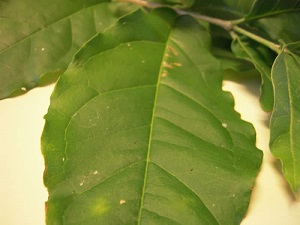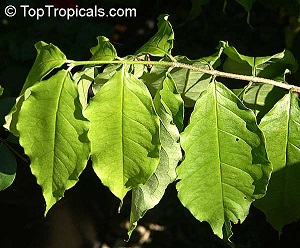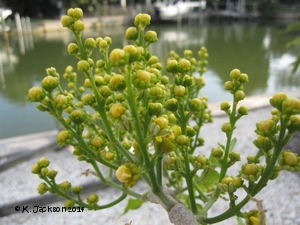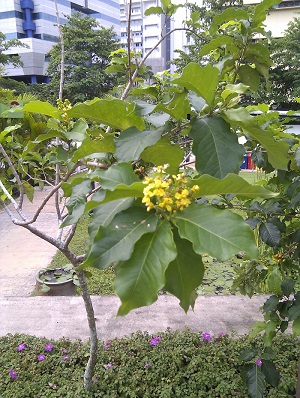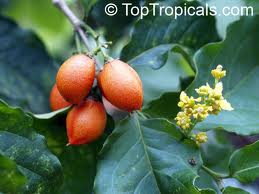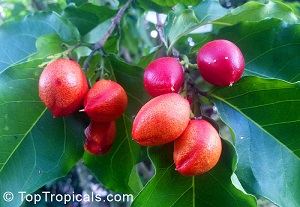| Peanut Butter Tree - Bunchosia glandulifera | |||||||||||||||
|---|---|---|---|---|---|---|---|---|---|---|---|---|---|---|---|
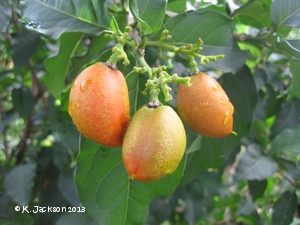 Fig. 1 Bunchosia glandulifera 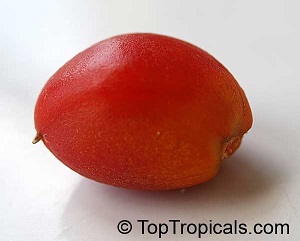 Fig. 2  Ripe fruit 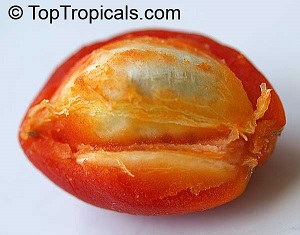 Fig. 3  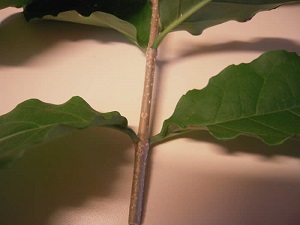 Fig. 4  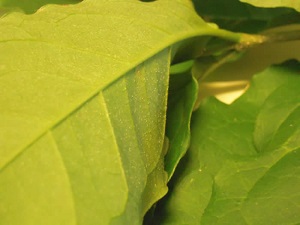 Fig. 5  Underside of leaf  Fig. 8  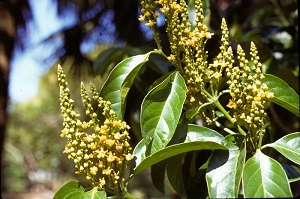 Fig. 9  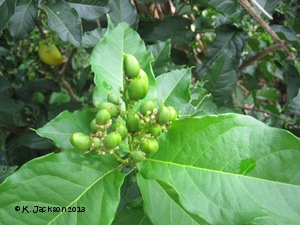 Fig. 13  Fruit forming  Fig. 14  Immature fruit 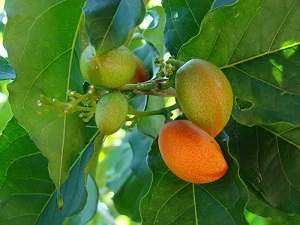 Fig. 15  Diffferent stages of maturity 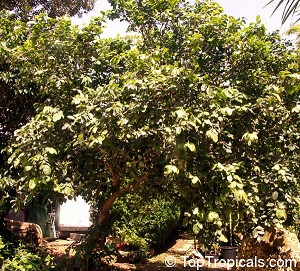 Fig. 18  Plant growth habit |
Scientific
name Bunchosia glandulifera (Jacq.) Kunth Bunchosia glandulifera was already described and the name validly published by Nicolaus Joseph von Jacquin. It was Karl Sigismund Kunth, however, who reclassified it into todays valid botanical systematics 5 Common names English: Monk’s Plum, Peanut Butter Fruit, Peanut Butter Tree; French: cafe bois, cafe moka, Bunchoise Des Andes; Japanese: Ameishia, arumeniaka, Bunkoshia, Piinattsu bataa furuutsu; Lithuanian: Abrikosinė andenė; Peru: Cansaboca, Huánuco; Portuguese: Ameixa-Do-Peru, Ameixa–Do-Para, Caferana, Cafezinho, Caramel; Russian: Bunkhoziia abrikosovaia; Spanish: ciruela, cafe falso Synonyms Bunchosia emarginata var. martinicensis Urb. & Nied., B. hypoleuca Miq., B. martinicensis (Urb. & Nied.) Small, Malpighia glandulifera Jacq. 4 Family Malpighiaceae Origin Native to South America and the West Indies USDA hardiness zones 10 Uses Fruit Height 10-15 ft (3.05-4.57 m) Plant habit Shrub or tree like; starts fruiting within 2-3 years from seed Growth rate Moderate Leaves Wavy at the margins; underside slightly hairy; simple, entire, opposite Flowers Arranged in racemes (Fig. 5) Fruit Drupe; round, dark red, rich, sweet flesh; texture similar to peanut butter Season Summer Light requirement Sun, part shade Soil tolerances Prefers fertile with organic matter 8 pH preference 6-7.6 Drought tolerance Prefers moist soil Cold tolerance 28 °F (-2 °C) 9 Invasive potential * Not known Known hazard The seed or pit is said to be poisonous Reading Material Peanut Butter Fruit or Plant, Arthur Lee Jacobson Bunchosia argentea *, commonly known as Peanut Butter Fruit, is a species of flowering plant in the acerola family, Malpighiaceae, that is native to Venezuela and Colombia in South America. It produces small orange fruits with sticky, dense pulp and a flavour resembling that of dried figs or peanut butter, hence the name. Additionally, the scent is unmistakably of peanut butter. Mostly eaten fresh, also used for jellies, jams, or preserves. It is cultivated in South Florida. It is one plant on display at the "Living with the Land" attraction at the Epcot, Disney World, Orlando. 1 * B. glandulifera - usually misidentified in U.S. horticulture as Bunchosia argentea 7 Origin Native to Northern and Western South America: Venezuela and Columbia. Naturalized In Southern America: Caribbean (Grenada; Guadeloupe; Martinique; Montserrat; Puerto Rico); Northern and Western South America: Guayana; Suriname, Bolivia; Ecuador; Peru and Brazil. Description This attractive tree has clusters of yellow flowers that are followed by an abundance of dark red fruit to around 2.5cm long. The rich, sweet flesh has a texture similar to peanut butter. Leaves The two species are easily distinguished. In B. argentea (Jacq.) DC. the leaves are flat, and the back side of the leaf is silvery due to very dense appressed hairs that completely hide the epidermis (the name "argentea" refers to that silvery indument). In B. glandulifera the leaves are notably wavy at the margin (Fig. 10) ; on the back side of the leaf there are hairs, but they are not nearly dense enough to hide the epidermis (Fig. 9). All the photos seen on other websites of plants that are supposed to be B. argentea are actually B. glandulifera. As far as is known, B. argentea is not and never has been cultivated. 3
Flowers
Fruit
Harvesting When the fruit is dark red Propagation By seed Food Uses The fruit can be eaten fresh or made into milk shakes. General The generic name honours Marcello Malpighi, a 17th-century Italian physician and botanist. 2 One species, B. glandulifera (Jacq.) H. B. K., is cultivated as a decorative small tree in towns and cities throughout much of South America and in Cuba, and its large red-orange fruits are eaten (see discussion in W. R. Anderson, 2001a, p. 103). At some point B. glandulifera was introduced to the horticultural trade in the United States as "B. argentea", and it is widely sold under that name. 3 The name Bunchosia is said to come from an Arabic word, bunchos, meaning coffee, for the resemblance of the seed-containing pyrenes of the fruit to the mericarps of Coffea arabica. 6 List of Growers and Vendors |
||||||||||||||
| Bibliography 1 "Brunchosia argentea." wikipedia.org. Web. 9 Feb. 2015. 2 Quattrocchi, Umberto. CRC World Dictionary of Plant Names: Common Names, Scientific Names, Eponyms, Synonyms, and Etymology. 3. p. 1601. ISBN 978-0-8493-2673-8. 2000. Print. 3 Anderson, W. R., Anderson, C. and Davis, C. C. "Malpighiaceae, Bunchosia H.G.K." herbarium.lsa.umich.edu/malpigh/index.html. University of Michigan, Herbarium. Web. 9 Feb. 2015. 4 Bunchosia glandulifera (Jacq.) Kunth. theplantlist.org. Web. 26 Dec. 2016. 5 Bunchosia glandulifera. hortipedia.com. Web. 26 Dec. 2016. 6 Anderson, W. R., Anderson, C. and C. C. Davis. Malpighiaceae, Bunchosia H.G.K. herbarium.lsa.umich.edu/malpigh/index.html. Web. 26 Dec. 2016. 7 Jacobson, Arthur Lee. "Peanut-butter Fruit or Plant." Plant of the Month: May 2011. www.arthurleej.com. 2011. Web. 8 Jan. 2015. 8 Lim, T. K. "Edible Medical and Non-Medical Plants Volume 3, Fruits." p. 150. 2012. Print. 9 Fruits of Warm Climates. Julia F. Morton, Miami, 1987. Photographs Fig. 1,10,11,13,14 Jackson, Karen. Peanut Butter Tree Series. 2013. growables.org. Web. 10 Feb. 2015. Fig. 2,3,7,8,16,17.18 Brunchosia argentea. N.d. toptropicals.com. Web. 10 Feb. 2015. Fig. 4,5,6 Robitaille, Liette. Peanut Butter Leaves. 2014. growables.org. Web. 10 Feb. 2015. Fig. 9 Howard, R.A. Bunchosia glandulifera. N.d. Smithsonian Institution, National Museum of Natural History, Department of Botany. collections.nmnh.si.edu. (CC BY-NC-SA 3.0). Web. 26 Dec. 2016. Fig. 12 techieoldfox. Flowering branch. N.d. tropical.theferns.info. (CC BY-NC-SA 2.0). Web. 1 Mar. 2017. Fig. 15 Ghosh, Asit K., Thaumaturgist. Fruits of the Peanut Butter Fruit (Bunchosia argentea/Malpighiaceae) tree. 2007. commons.wikimedia.org. At ECHO (Educational Concerns for Health Organization), Ft. Myers, Florida. Web. 10 Feb. 2015. * UF/IFAS Assessment of Non-native Plants in Florida's Natural Areas ** Information provided is not intended to be used as a guide for treatment of medical conditions. Published 10 Feb. 2015 LR. Last update 2 Mar. 2017 LR |
|||||||||||||||
